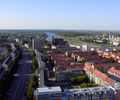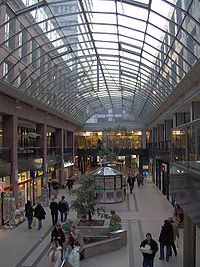
Oderturm
Encyclopedia



Frankfurt (Oder)
Frankfurt is a town in Brandenburg, Germany, located on the Oder River, on the German-Polish border directly opposite the town of Słubice which was a part of Frankfurt until 1945. At the end of the 1980s it reached a population peak with more than 87,000 inhabitants...
, Germany
Germany
Germany , officially the Federal Republic of Germany , is a federal parliamentary republic in Europe. The country consists of 16 states while the capital and largest city is Berlin. Germany covers an area of 357,021 km2 and has a largely temperate seasonal climate...
, built between 1968 and 1976 (when the city was in East Germany). It is arguably the tallest office building in Brandenburg
Brandenburg
Brandenburg is one of the sixteen federal-states of Germany. It lies in the east of the country and is one of the new federal states that were re-created in 1990 upon the reunification of the former West Germany and East Germany. The capital is Potsdam...
, with a mobile telephony
Mobile telephony
Mobile telephony is the provision of telephone services to phones which may move around freely rather than stay fixed in one location. Mobile phones connect to a terrestrial cellular network of base stations , whereas satellite phones connect to orbiting satellites...
mast reaching 95 m; however, its roof height of 89 m is 1 m less than that of the Stern-Plaza in Potsdam
Potsdam
Potsdam is the capital city of the German federal state of Brandenburg and part of the Berlin/Brandenburg Metropolitan Region. It is situated on the River Havel, southwest of Berlin city centre....
, built in 1998. (The 107-m hall containing Tropical Islands
Tropical Islands
Tropical Islands Resort is an artificial tropical resort in Krausnick, Germany. It is said to have the world's largest tropical indoor pool which can accommodate up to 8,000 visitors a day...
and the 161-m steam generator at Schwarze Pumpe power station are taller structures, though they lack occupied floors.)
The tower was designed by a collective under architects Hans Tulke and Paul Teichmann and built in part by Free German Youth
Free German Youth
The Free German Youth, also known as the FDJ , was the official socialist youth movement of the German Democratic Republic and the Socialist Unity Party of Germany....
(FDJ) work brigades; construction lasted nearly eight years. It was planned as an office building, but when it opened it housed a 274-bed dormitory for workers in the Frankfurt semiconductor
Semiconductor
A semiconductor is a material with electrical conductivity due to electron flow intermediate in magnitude between that of a conductor and an insulator. This means a conductivity roughly in the range of 103 to 10−8 siemens per centimeter...
plant, as well as a 160-bed Youth Tourist Hotel (Jugendtourist-Hotel), similar to a youth hostel, but geared towards organized meetings such as the Whitsuntide meetings of the FDJ with its Polish counterpart, the ZSMP, of which the 1977 meeting, not long after the opening of the hotel, was the most significant. The ground level of the tower complex was made up of two three-storey buildings with an open-air shopping passage between them, which included a 400 m2 supermarket (Kaufhalle) and the popular Oderland-Grill restaurant
Restaurant
A restaurant is an establishment which prepares and serves food and drink to customers in return for money. Meals are generally served and eaten on premises, but many restaurants also offer take-out and food delivery services...
, while the 23rd floor featured a panoramic cafe.
After German reunification
German reunification
German reunification was the process in 1990 in which the German Democratic Republic joined the Federal Republic of Germany , and when Berlin reunited into a single city, as provided by its then Grundgesetz constitution Article 23. The start of this process is commonly referred by Germans as die...
, the building was refurbished in 1992 to 1994, following the plans of architect Monika Krebs, when it opened as the Oderturm. The tower became an office building, the cafe was removed, and the lower buildings were transformed, with new construction, into an enclosed shopping mall
Shopping mall
A shopping mall, shopping centre, shopping arcade, shopping precinct or simply mall is one or more buildings forming a complex of shops representing merchandisers, with interconnecting walkways enabling visitors to easily walk from unit to unit, along with a parking area — a modern, indoor version...
. A large illuminated sign was added to the roof, making the Oderturm an easily identifiable landmark. A cafe, Turm24, returned to the 24th floor in 2000.
The Oderturm figured prominently in the 2002 film Halbe Treppe (Grill Point
Grill Point
Grill Point is a 2001 German drama film directed by Andreas Dresen. Its original German title is Halbe Treppe, which means "Halfway up the Stairs" in English, and was the real-life name of the snack bar shown in the film....
).
External links
See also
- Jen-TowerJen-TowerThe JenTower is a skyscraper in Jena, Germany.-Common names:The tower has been known by many names, official and unofficial. From 1972 Until January 2005, the tower was called the Intershop Tower after its principal tenant, Intershop Communications AG. On November 30, 2004, the building was...
- City-Hochhaus LeipzigCity-Hochhaus LeipzigCity-Hochhaus , at a height of 142.5 metres, is the tallest building in the city of Leipzig, and the tallest multistory building erected in the former East Germany. It was designed by architect Hermann Henselmann in the shape of an open book, and built between 1968 and 1972...
- Park Inn BerlinPark Inn BerlinThe Park Inn by Radisson Berlin Alexanderplatz is the tallest building and the eleventh tallest structure in Berlin and the 29th tallest building and tallest hotel-only building in Germany...
- Fernsehturm
- KulturfingerKulturfingerThe Kulturfinger is the nickname of a steel-framed tower built during the days of the communist German Democratic Republic that is the tallest building in Neubrandenburg, Germany...
Literature
- Architekturführer DDR: Bezirk Frankfurt (Oder). First edition, 1984. Ingrid Halbach, Matthias Rambow, Horst Büttner, Peter Rätzel. VEB Verlag für Bauwesen, Berlin.

